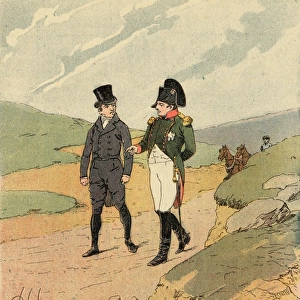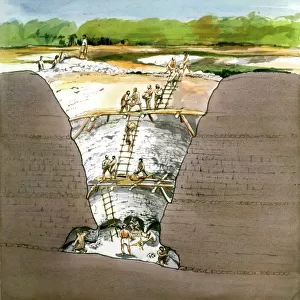Framed Print > Europe > United Kingdom > Wales > Flintshire > Flint
Framed Print : 19th Century Flint Glass Prism L. tif C008 / 9532
![]()

Framed Photos from Science Photo Library
19th Century Flint Glass Prism L. tif C008 / 9532
Computer artwork of 19th century flint glass prism c. 1790, mounted on a rotating brass stand, of a type used to repeat experiments by Sir Isaac Newton. A narrow slit of light from the sun is focussed along the length of the prism from above, which is refracted by the prism into the colour spectrum and projected onto the surface below. In Isaac Newtons time, it was believed that white light was colourless, and that the prism itself produced the colour. Newtons experiments convinced him that all the colours already existed in the light in a heterogeneous fashion, and that " corpuscles" (particles) of light were fanned out because particles with different colours travelled with different speeds through the prism. It was only later that Young and Fresnel combined Newtons particle theory with Huygens wave theory to show that colour is the visible manifestation of lights wavelength
Science Photo Library features Science and Medical images including photos and illustrations
Media ID 6316243
© DAVID PARKER/SCIENCE PHOTO LIBRARY
Brass Colour Colourless Corpuscles Experiment Flint Focus Glass Huygens Isaac Newton Light Particles Prism Projection Theory Wave Wavelength White Light Young Fresnel Visible Spectrum
12"x10" Modern Frame
Discover the captivating allure of science's past with our Media Storehouse Framed Prints. This exquisite piece showcases a computer-generated illustration of a 19th century flint glass prism, inspired by the original design from the Science Photo Library (C008 / 9532). Depicting the iconic prism from around 1790, this captivating print is mounted on a rotating brass stand, reminiscent of the ones used by Sir Isaac Newton during his groundbreaking experiments. Add an air of historical sophistication to your home or office decor with this stunning, scientifically accurate representation of a pivotal moment in scientific history. Order your Media Storehouse Framed Print today and bring a piece of the past into your present.
10x8 Print in an MDF Wooden Frame with 180 gsm Satin Finish Paper. Glazed using shatter proof thin plexi glass. Frame thickness is 1 inch and depth 0.75 inch. Fluted cardboard backing held with clips. Supplied ready to hang with sawtooth hanger and rubber bumpers. Spot clean with a damp cloth. Packaged foam wrapped in a card.
Contemporary Framed and Mounted Prints - Professionally Made and Ready to Hang
Estimated Image Size (if not cropped) is 25.4cm x 25.4cm (10" x 10")
Estimated Product Size is 30.5cm x 25.4cm (12" x 10")
These are individually made so all sizes are approximate
Artwork printed orientated as per the preview above, with landscape (horizontal) or portrait (vertical) orientation to match the source image.
FEATURES IN THESE COLLECTIONS
> Arts
> Artists
> Y
> Art Young
> Europe
> United Kingdom
> Wales
> Flintshire
> Flint
> Historic
> Famous inventors and scientists
> Isaac Newton
> Science
> Scientists
> Sir Isaac Newton
EDITORS COMMENTS
This print showcases a remarkable piece of scientific history - a 19th-century flint glass prism mounted on a rotating brass stand. This particular type of prism was used by the legendary Sir Isaac Newton to conduct groundbreaking experiments. In the image, a slender beam of sunlight pierces through a narrow slit and is directed onto the top surface of the prism. As it passes through, the light is refracted, splitting into its constituent colors and creating a mesmerizing spectrum that is projected onto the surface below. During Newton's era, there was an erroneous belief that white light had no color and that prisms themselves produced these vibrant hues. However, Newton's meticulous experiments shattered this misconception. He discovered that all colors already existed within white light in an intricate manner. Newton's revolutionary findings revealed that different colored particles traveled at varying speeds through the prism, causing them to disperse or fan out accordingly. These particles were later referred to as "corpuscles" - tiny entities composing light itself. It wasn't until later when scientists Young and Fresnel merged Newton's particle theory with Huygens' wave theory that they fully comprehended how color manifests as visible wavelengths of light. This extraordinary artwork not only captures the beauty of science but also symbolizes humanity's relentless pursuit of knowledge and understanding in unraveling nature's mysteries.
MADE IN THE USA
Safe Shipping with 30 Day Money Back Guarantee
FREE PERSONALISATION*
We are proud to offer a range of customisation features including Personalised Captions, Color Filters and Picture Zoom Tools
SECURE PAYMENTS
We happily accept a wide range of payment options so you can pay for the things you need in the way that is most convenient for you
* Options may vary by product and licensing agreement. Zoomed Pictures can be adjusted in the Cart.



















